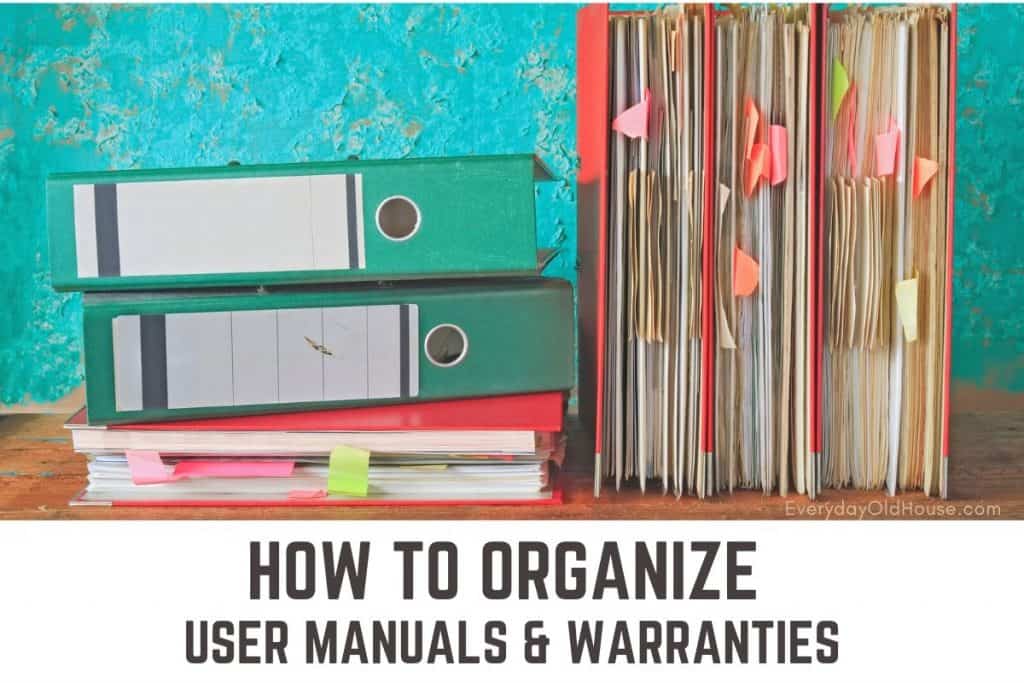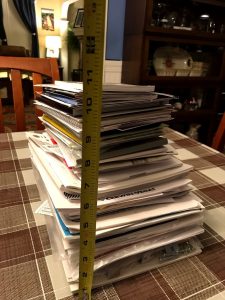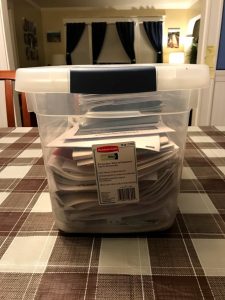Last Updated on January 5, 2024
It’s January, and you know what that means for us homeowners. A renewed resolution to declutter, organize, and refresh our homes. Personally, I planned major organization projects, like finally tackling our unfinished basement filled with toys, tools, furniture and just crap from over the years.
But here’s the problem.
I don’t have the energy, motivation, or time to do it.
You know that feeling, right?
So, I’ve changed my strategy. Instead of tacking behemoth projects, I’ve decided to work in small, bite-sized chunks of organization. And one of the easiest and quickest organization tasks? Organize user manuals, warranties, and receipts.
Organizing my family’s owner manuals took less than the duration of a movie (thank you Netfix), and now these user guides are easily accessible whenever I need them. It will save hours of time, aggravation, money, headaches, and clutter for me in the future.
Feels good to know at least one thing in my house is organized!
And here I’ll teach you how to do the same. Here’s a simple way to organize your owner manual and warranties and other reference paperwork.

This post contains affiliate links, including but not limited to, Amazon Associates. As such, I earn from qualifying purchases. Full disclosure located here.
Why Should I Organize my Owner Manuals?
Let’s first go over the reasons why you should even care about organizing user manuals. Sure, we all want to be organized, but in all honestly, a lot of us won’t find the time and energy to do it unless we have a darn good reason. So here’s a few reasons….

- Something Breaks – It’s quicker, easier, and a lot less frustrating to get a replacement from a manufacturer (by fulfilling all the requirements of a warrantee) when you have all the paperwork in one spot.
- Diagnose an issue with an appliance – The technology in appliances are complicated, and getting even more so every year. Having written instructions may help speed up understanding what is wrong.
- Recalls – With 300-400 recalls per year, there’s a probability something in your house that will recalled. If you receive wind of a recall, your user manual and receipt will help you quickly determine if your item falls under the recall.
- Question about how something works – Maybe you like the challenge of tinkering and trial and error, but I’d prefer to refer to a manual.
- Selling your house – You have enough to do when moving. Wouldn’t the home selling process be a smidge easier if the user manuals for the appliances left behind are already be organized for your home’s next owner?
OK, let’s get started!
Step 1: Where the Heck are My User Manuals?
Before organizing, you first must to actually find those user guides, receipts and warranties. Maybe this task is easy for you, but for me this is a bigger task than it should have been. Not saying I’m a slob, but… ?
Hunt and gather up all those owner manuals floating around your house. Not sure where to look? Start here – these are probably the best places to find user manuals.
- Junk drawer: C’mon admit it, you have an overflowing catch-all junk drawer. Everyone does….
- File cabinet or boxes/baskets/areas where you store other house-related paperwork
- Packaging/ boxes: When we buy an item, my family tends to save the packaging until we know the items works correctly. Unfortunately, we also tend to forget about the packaging shoved in the back of a closet, or attic or basement until we declutter once a year…
Step 2: Which User Manuals Stay & Which Go?
If you a kid from the 80’s like me, this title might make you hum The Clash’s song “Should I Stay or Should I Go.” ?
Should I stay or should I go now?
If I go, there will be trouble
And if I stay it will be double
So come one and let me know...
Once you have collected all the scattered user guides and related paperwork into a central location, it’s time to determine what to keep and what to toss.
Time to breakout the recycling bin (you’re gonna need it!). Personally I ended up recycling about 1-2 inches of paper.

For decluttering my user manuals, I used a two-step method. The first is kind of obvious, and the second is optional if you truly feel like you need to keep alllllll of your manuals (but I really don’t think ya do….)
- First, toss (aka recycle) those user manuals, warranties and receipts for items that you no longer own.
- Second, decide which user manuals, warranties and receipt which are no longer useful to either maintaining or fixing items. My opinion on whether a user manual is useful?
Toss User Guides for SMALL and SIMPLE Items
- What are small and simple items? Hair dryers, hand mixers, and toys. If you know how it works and it’s not too expensive (i.e under $50), recycle the user guide. If it runs with an “off and on” switch, it’s safe to chuck. But if it has a few extra buttons, like an alarm clock, you might want to keep. You will undoubtedly have a power outage and won’t remember how to reset the clock.
Keep User Guides for BIG and SOPHISICATED Items
- What are bigger and complex items? Appliances like dishwashers, oven, washers and dryers. Large sports equipment and expensive toys like bikes. More expensive personal items, like cell phones, laptops and car seats. Personally I try to keep user manuals for anything over $50 in value.
Step 3: How to Organize that Pile of User Manuals
Now that you have pared down the pile, it’s time to organize those user manuals.
- Sort through paperwork that came with your purchase and toss any extraneous paperwork like coupons or manuals not in your native language. Keep the manual, warranty and receipt/ proof of purchase.
- Staple the warranty and receipt to the front of the manual. (For us Amazon Prime folks who don’t always get paper receipts, write down “Amazon” and month of purchase so that you can search through your orders in the future.
- Write the purchase date, model and serial number on front of the manual. Why? If an appliance is recalled, it helps tremendously as a quick and easy reference.
- Collate any special assembly keys (ex: Allen wrench/ Hex key) or spare parts. Tape them either directly to the manual or store in labelled plastic baggies. Think how easy it will be if you need to dissemble to move or sell it if you know exactly where that hardware is located.

Here’s my stack of user manuals.
As you can see, all these manuals add up to a bulky file. I store all my house’s paperwork in a two-drawer metal file cabinet. But looking at this bulky mass, it makes no sense to shove it into the file cabinet. These manuals would take up an entire drawer!
And chances are, you have a similar sized bulky pile of user manuals.
Consider a separate filing system (aka separate containers) to store these user manuals.
There appears to be some great container options on the market for storing this paperwork. But before you click buy, consider these 3 things:
- Size
- Style
- Categories
Size
To get a sense of how big a container you need, measure the height of your manuals. Add a few inches to accommodate user guides for further purchases. Use that measurement to find a container around that size.
You might even need more than one container depending on the type of container you pick (for example, 3-ring binders as mentioned below).
We are a family of five with a decent amount of user manuals. After decluttering, a quick count of manuals is 100-125. We have a lot more “stuff” than I thought! And the pile measures about a foot tall.
Style
This consideration is simple. Do you want fancy or plain? Will this container be out in the open, such as of a home office, or will it be shoved down into the unfinished basement? And the fancier you get, the more likely it will cost more.
We store most of our paperwork down in our unfinished basement, so style is unimportant to us. And while we have never had a problem with water in our basement, I like the idea of a plastic container (a few options listed below). Plastic will protect paper in the rare case of an extreme storm where we could get water in our basement.
Categories
After decluttering your user manuals, professional organizers suggest that you further organize user manuals by Categories. These subfolders provide a more efficient use of your pile of user manuals.
It’s a personal choice which categories you choose, but here’s a few suggested categories to organize user manuals.
- Electronics/ Technology (televisions, computers, phones, cameras)
- Large appliances (water heater, dryer, dishwasher)
- Small appliances (coffee machine, mixer, bread maker)
- Furnishings (couches, television stands)
- Outdoor and Garden (lawnmower, snowblower, pool)
- Tools
- Kids/Toys (cribs, strollers, doll house)
- Sports (bikes, snowboards)
- Miscellaneous
If interested, determine your categories and separate manuals into these categories into smaller piles of user manuals.

Honestly, I believe Categories are an optional step. I’m OK with not further diving up my home manuals. I’ve found all the manuals scattered all around my house and have them in a central location – I’m good with that.
Sure it may take a few more minutes to find a particular manual when I need it. But I rarely have to find one, so I’m OK with my organization system.
Step 4: Containers to Organize User Manuals
OK – on to the next step. Now it’s on to finding a container to store all the manuals. There are a TONS of different options for sale, but here’s a couple of ones (divided into Storage Bins, Binders, and File Boxes) that caught my eye.
Storage Bins
If you decide that you don’t want further organize user manuals in categories (like me), then a simple storage bin should work.
Although I searched online for a storage bin, I actually didn’t buy one. I was lucky enough to find this Rubbermaid clear plastic storage bin lying around in my basement. It was the perfect size (19 quarts which measures to around 11 in by 10 in by 13 in). I love the handle construction – and the ability to see inside the container.

But, here’s a few options I found on Amazon (before I found the extra Rubbermaid bin in my basement) that I think are worth checking out.
1. IRIS USA, Inc. Stack & Pull Box
This Amazon #1 Bestseller in the Lidded Home Storage Bins category (for the 6-pack of 19-quart size) meets a variety of storage needs for homes.
These bins are functional, practical, and cost-effective. Plus, they are stackable to make the most of limited space.
Unfortunately, bins aren’t sold separately on Amazon. These bins are available in multi-pack options. BUT chances are you will need another storage tote sooner or later for another organizing project…
These bins have a 4.3 out of 5 star rating (December 2023, 950 ratings) with the biggest complaint related to splitting plastic.
2. AmazonBasics Foldable Burlap Cloth Cube Storage Bin with Lid
If you want something a bit classier than a plastic bin, AmazonBasics has a cute Burlap Cloth Cube Storage Bin in a neutral color.
It’s perfect for a home office (someday I’ll have an office!) This cube is foldable (expands to 13 in x 13 in x 13 in) and comes with a lid and side handles. Cubes are sold separately or in a set of 2.
The bottom board allows the storage cube to fold and unfold easily with 2 side handles for easy access and carrying. The reviews are very favorable (4.6 out of 5 stars) with over 75% of customers awarding 5 stars (December 2023, 1600+ reviews).
Binders
If you take the professional organizers’ advice and categorize your user manuals, binders may be a perfect option. They keep everything together and you can easily and quickly add dividers and labels.
Professional organizers recommend large (i.e. 3 or 4 inch) 3-Ring binders with clear pocket protectors and dividers to separate by categories. Some folks may even make a cover sheet for the binders. Label your binders with covers (I like the look of this binder cover from Erin at My Frugal Home).
Chances are you’ll need more than one binder. And what’s nice about that? It gives the opportunity to separate binders and place throughout your house where it makes sense. For example, you can keep all the user manuals for kitchen appliances in one binder right in the kitchen, versus storing all user manuals in one location (like for us, all down in the basement).
3. Carstens Heavy Duty 3-Ring Binder
If you want a snazzy binder, check out Carsten’s Heavy Duty Ring binders. Available in both 3-inch and 4-inch and in almost a dozen colors (I especially love the Pool Blue color – the prettiest color binder I’ve seen!).
Carstens has been in business for over 130 years, make their products (comprised of US and imported parts) in the USA , and is a WBENC certified Woman-Owned Small Business.
Carstens’ binders are made from premium plastic to resist tearing and bending in even the most demanding work environments. I like that this non-porous binder surface is impenetrable to air and liquids, so bacteria (aka mold) cannot grow beyond the surface (versus standard vinyl binders that can absorb liquids and harbor bacteria). This a perfect feature if you plan to store these in your basement that may have humidity problems.
4. Samsill Durable 3 Ring View Binders
For a more frugal option, Samsill offers 2-packs of basic binders for a reasonable price. These binders come in a variety of sizes, including 4-inch, 5-inch, even 6-inch! As of January 2023, these are rated high (4.6 out of 5 stars) with over 2,850 reviews.
NOTE: If you do decide to use binders to organize user manuals, you will also need these two accessories:
- Plastic sleeves/ page protectors for 3-ring binders (available in packs of 200 or packs of 50) to hold the manuals
- Dividers with tabs to label the categories
File Box
If you want to organize user manuals by category, but prefer to store them all in one container, check out these hanging file boxes.
5. Akro-Mils 12-Gallon Plastic Storage Hanging File Box
This semi-clear 12-gallon plastic hanging file box is a generous size at 21-1/2-Inch by 15-Inch by 12-1/2-Inch (interior dimensions are obviously smaller). Comprised of plastic, it’s sturdier than fabric, is stackable, and protects important documents from moisture.
This hanging file box comes with metal interior rails to organize letter hanging folders and attached lid. Note that it only holds letter-sized files and not legal-sized (although in my experience all my user manuals were letter-sized or smaller so I don’t think it’s an issue) Reviews are favorable with 4.6 out of 5 stars (over 1,000 reviews) as of January 2023, with the biggest criticism being cracked plastic.
6. Calico Commerce Collapsible File Box Storage Organizer with Lid
A fancier option is this collapsible, lidded file store box with linen fabric with lid, providing a soft accent to home offices.
The accompanying 4 removable brackets can handle both letter or legal sized folders – your choice. These metal brackets allow for a snag free design that run the length of the box to prevent files from falling off while allowing lid to close securely.
Label inserts are located on two sides for versatile file storage.
I like this particular one because of the inner metal brackets that hold the hanging folders along the side of the box. Similar file boxes don’t have these sliding rails, which means hanging folders directly on the fabric sides the results in poor sliding of files.
Amazon reviews are favorable for this file box with a rating of 4.4 out of 5 stars (December 2023, 800+ reviews).
7. Other File Box Options
If you want a different color besides the grey one above, check out this bestselling Collapsible File Box (note they don’t have sliding rails). Or this collapsible one in several colors and patterns that adds a pop of color in a home office. All have at least 4 out of 5 star reviews (as of January 2023).
For those of with bad backs, check out this bamboo file organizer on wheels (comes in natural color shown here as well as cafe noir). The storage container includes 4 durable wheels so you can easily roll the file cabinet wherever you need it. Includes brakes on 2 wheels so you lock the cabinet into place if needed. As of January 2023, 4.5 out of 5 stars with over 650 reviews.
If you are looking for a a more frugal file box on a dolly option, here’s a grey fabric file box on wheels.
Note that some of these file boxes may come with hanging files, some don’t. If not, I like the looks of these jewel-colored AmazonBasics (letter-sized, 25 per box).
5. Organize User Manuals Task is COMPLETE!
Check this little decluttering task or organizing your owner manuals, warranties and receipts off your list, because you are done! Feels good, doesn’t it???
A few items to conclude:
- Every year or so, skim through your user manuals to ensure you haven’t sold or thrown out items. Remove those user manuals and recycle.
- As with more organizing systems, remember to be consistent in your approach. Pick one option (i.e. binder or storage bin) and stick to it. Having one system will prove invaluable when your washer spurts out water or a wheel falls off the lawnmower…
But wait , there’s more!
How to Store Owner Manuals Electronically
It doesn’t seem right to talk about paper organization without touching upon the option of completely ditch the paper. While I respect those that can pare down paperwork in their house to a complete minimum, personally I am not there yet. (But I’ll be sure to write a blog post about it when I do!)
But if you do go this route, here’s a few suggestions before you dispose of those user manuals:
- Record the model numbers, serial numbers, and dates or purchase electronically on a simple spreadsheet using on Google Sheets or Microsoft Excel, or an app like Evernote. For receipts, consider scanning and saving to your computer or cloud storage such as Google Drive.
- Conduct an online search for your specific model’s manual (probably in pdf form) to make sure it’s available online.
- Either save the link to the user guide and warranty OR (preferably) download and save it in a folder on your computer or Google Drive.
Some manufacturers are already helping customers ease into a paperless environment by opting for online manuals and placing paper “Start Up” guides with the product.
Or you can download the free app Centriq recommended by This Old House in this video. Per the below video, this app is a soup to nuts home organization system. If you scan the nameplate on an appliance, not only will it bring up the user manual, but also gives you the ability to buy new parts.
This app sounds pretty spectacular, but I’m not quite ready to pull the trigger. Don’t get me wrong, I’m not completely adverse to apps for my home.
Last year I tried my first home app one – HomeZada – to compile a home inventory. If you don’t have a home inventory, I’d recommend reading 12 Reasons Why You Need a Home Inventory. This app will save you both money and frustration in the event of a fire of tragedy in your home).
But I digress, back to this Centriq app and storing user manuals electronically. Maybe next in a few months I’ve give it a shot (or more likely next January when resolutions kick back in).
OK – now that your user manuals, warranties and receipts are all organized, ready to tackle another small decluttering task in your home? How about organizing a tiny linen closet? Or perhaps take on organizing your family’s paperwork? I’ve currently undertaken 2 of the 3 steps to compile and organize all our important paperwork – from birth certificates to tax returns! The first step? Using this free printable checklist to find 60+ Important Papers and Documents For a Home Filing System (Checklist)
Related Posts
Want to be the first to know about new posts? Be sure to follow me on Pinterest, Facebook, Instagram or Twitter of even Etsy! Or better yet… Subscribe below!
My monthly (admittedly sometimes more, sometimes less….) emails are like receiving a unexpected letter from an old friend WITHOUT needing to put on your slippers and walk out to your mailbox…. See? I got ya, my friend!)
[Note: My posts are proudly connected to these amazing link parties full of DIY ideas and inspiration!]









What a helpful article! I need to do this.
Thanks Donna! I found that just tackling this small decluttering and organizing task made me feel better about my home. And I’s slightly more motivated to start another project soon.